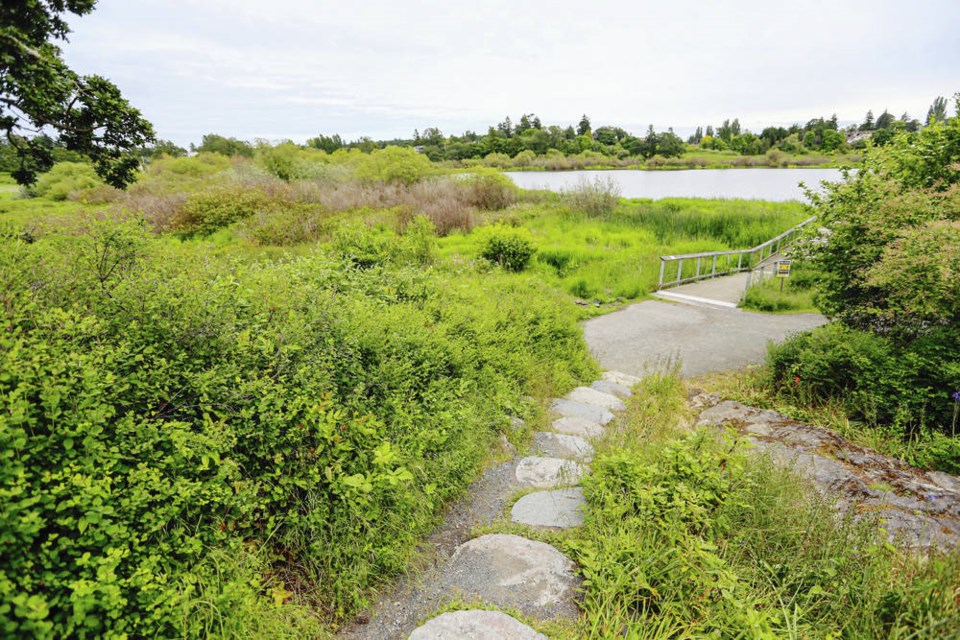A delightful and enchanting little book arrived at my door this week titled Lakes of Victoria, sa���ʴ�ý, by Adam Ungstad (2021).
Did you know that Spectacle Lake, a lovely warm swimming lake off the Malahat with a picnic area and woodland trail, got its name from its eyeglass shape? (I don’t see it myself, but somebody obviously did.)
Have you heard of Lake Ida Anne? It’s a little manmade body of water in Langford that’s primarily used for fishing lessons.
These two, plus 29 other lakes, are described in this lovely book, which contains numerous interesting facts on freshwater ecosystems. Dragonflies, for example, spend much of their life underwater, non-native freshwater jellyfish about the size of your thumbnail live in Killarney Lake, and the harmful (often poisonous) blue-green algae “blooms” that block sunlight from entering lakes are not actually algae at all — the bloom is a bacteria called cyanobacteria, one of the oldest life forms on earth.
Lakes and their surrounding landscapes are worth a visit. You may observe a beautiful arrangement of pond lilies, which are different from water lilies. The pond lilies are native to Vancouver Island and “form a golden yellow cup,” whereas water lilies, although pretty in various pastel hues, are an introduced flora in our lakes.
The book also contains historical information — it’s said that there’s a piano at the bottom of Florence Lake, while Swan Lake, now home to a popular environmental educational centre and nature trail, exhibited good Feng Shui to the Chinese community, with balanced geographical aspects including the shape of the lake: an oval pearl.
But all is not perfect in the lakes for many reasons, including the presence of several harmful non-indigenous flora and fauna, although the good news is that we can remedy many of these issues, and there is indeed growing awareness and meaningful action taking place.
One of the most invasive arrivals is the American bullfrog, which can eat a ducking in just one gulp as well as scores of other native creatures throughout the day. They can weigh over a pound and the female is able to lay 20,000 eggs!
I read that these great bulbous bullies, originally from France, were obtained by New York restaurants for their legs! Some, however, escaped and eventually made it to the West Coast.
Invasive flora and fauna are obviously a major issue for lakes, which is addressed in The Death and Life of the Great Lakes by American journalist Dan Egan (2017, W.W. Norton & Company), a Pulitzer Prize finalist. In this fascinating, albeit alarming, book, Egan argues that the invasive quagga and zebra mussels are worse than an oil spill.
To give an idea of the size of these waters, the author writes that “the lake bottoms are littered with an estimated 6,000 shipwrecks, many of which have never been found,” not to mention a crashed domestic aircraft.
He describes the “resuscitation” of the lakes through the elimination of industrial and household wastes, noting, however, that the Clean Water Act did not address the most serious problem, that of “living pollution” or noxious species that invaded and decimated the lakes via dumping of the ballast of foreign freighters.
The author says the ballast “swarms with perhaps the most potent pollutant there is: DNA.” Pumped into ships in a foreign port, ballast is the water held within the ship for balance and weight distribution. Ballast makes the freighter so heavy that when the cargo is loaded in the Great Lake ports, it’s pumped out — “up to ten Olympic-sized swimming pools’ worth per ship — and all the life lurking in it gets set loose in the lakes.”
The small but mighty aggressive razor-like zebra and quagga mussels are thought to have hitched a ride from the Black and Caspian Seas and, according to the author, have decimated the lakes’ natural ecosystems.
We think the crystal-clear water of the Great Lakes is a good sign, but the author argues just the opposite: “This is not the sign of a healthy lake; it’s the sign of a lake having all the life sucked out of it.”
If you would like to learn more about invasive species here in British Columbia, I discovered a grand little book for both adults and children in the sa���ʴ�ý Museum’s shop, Aliens Among Us by Alex Vantol (2015, Royal sa���ʴ�ý Museum). Cut down your Giant Hog Weed!
You may recall last year that during a lengthy and heavy rainfall, several Dallas Road banks tore loose, sending tons of debris, earth and vegetation crashing onto the beach below, but alas, the two shrubs that hung on with their mighty grip and remained intact were Scotch broom and the thorny gorse!



